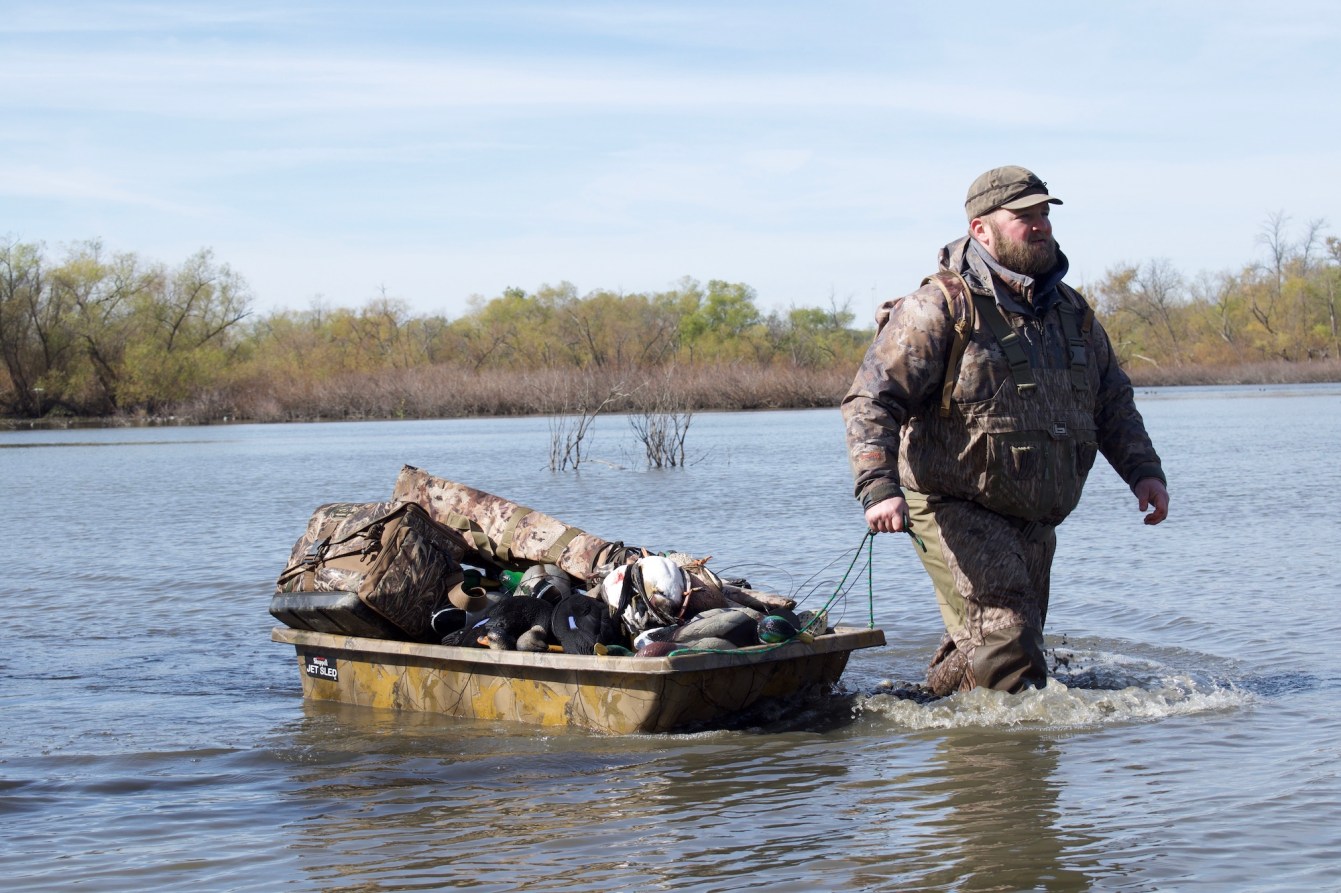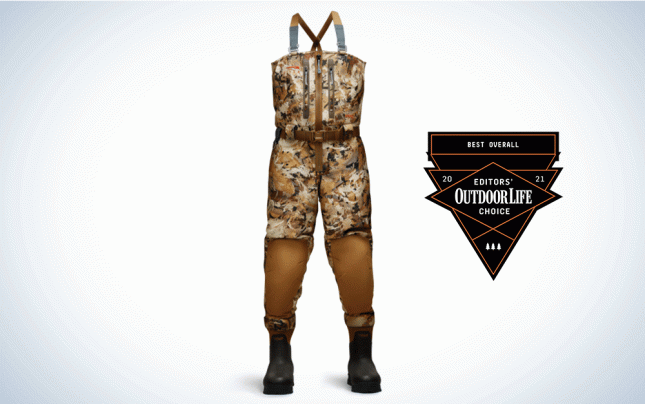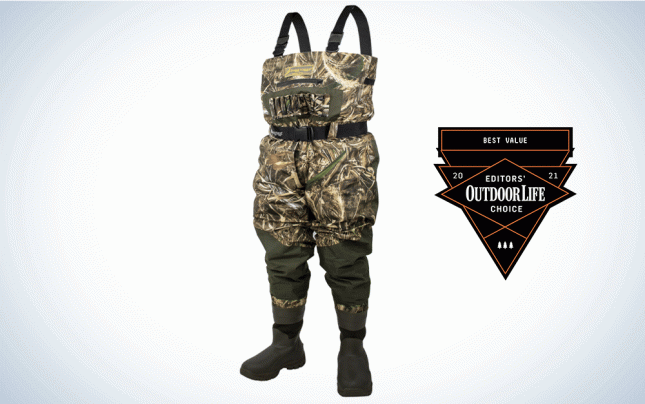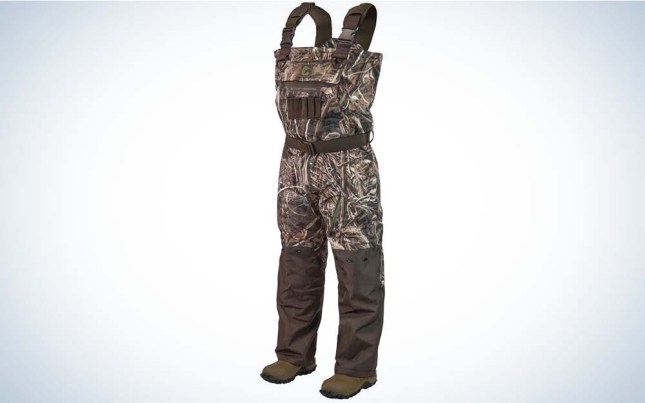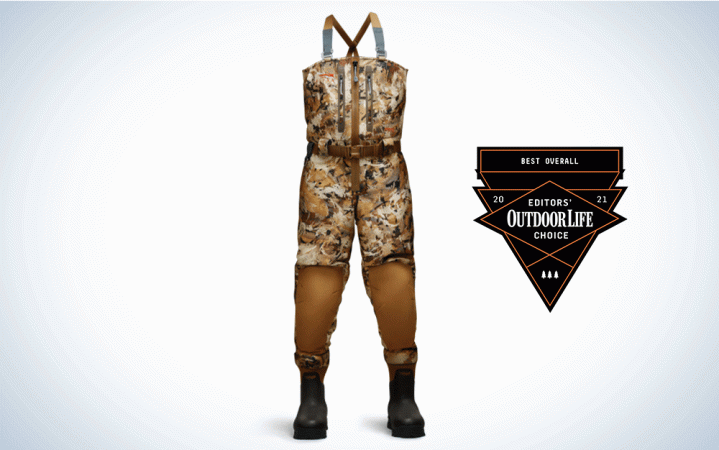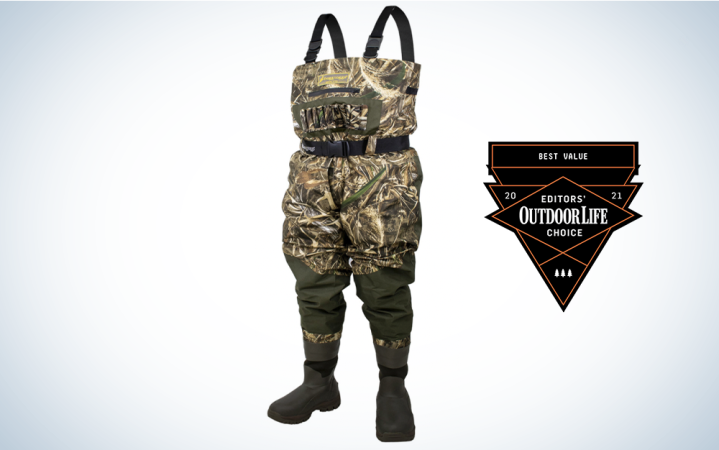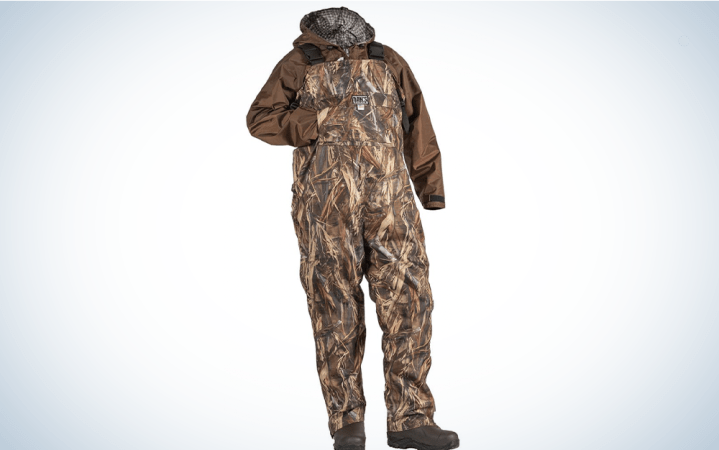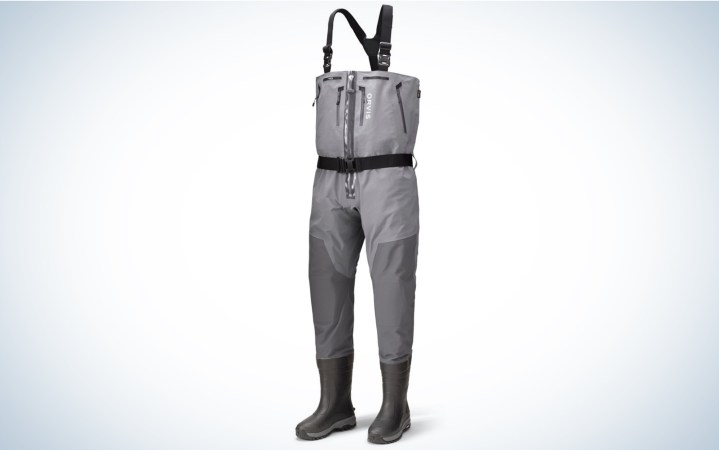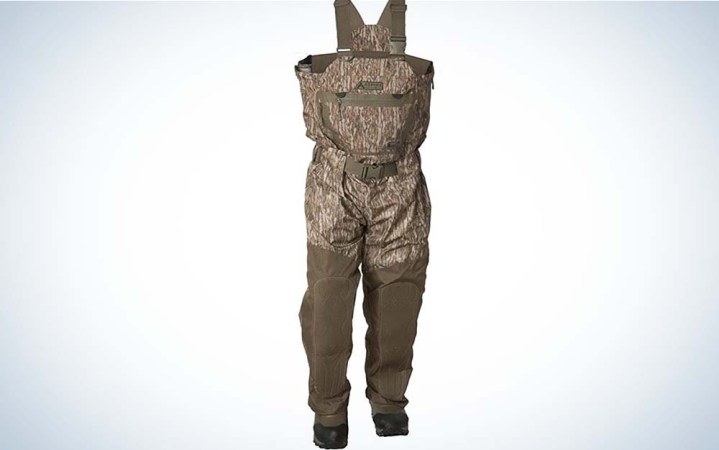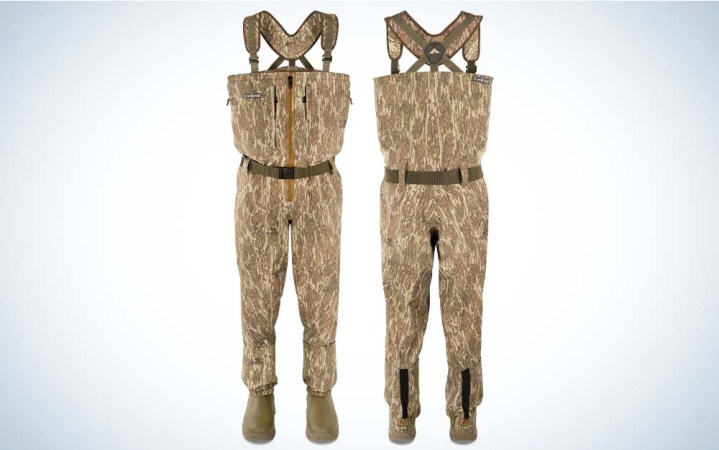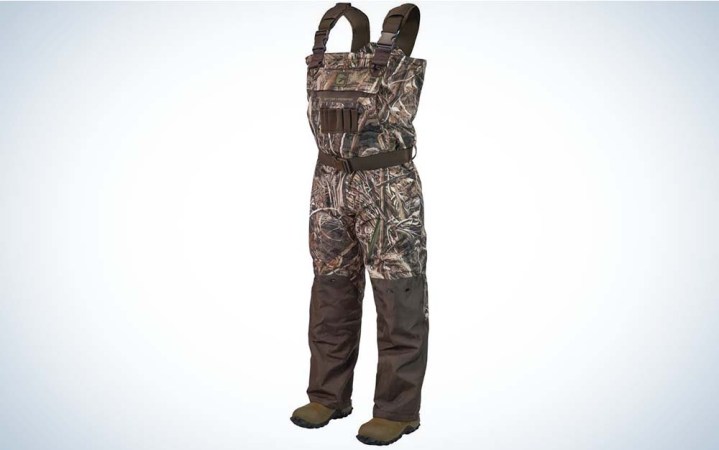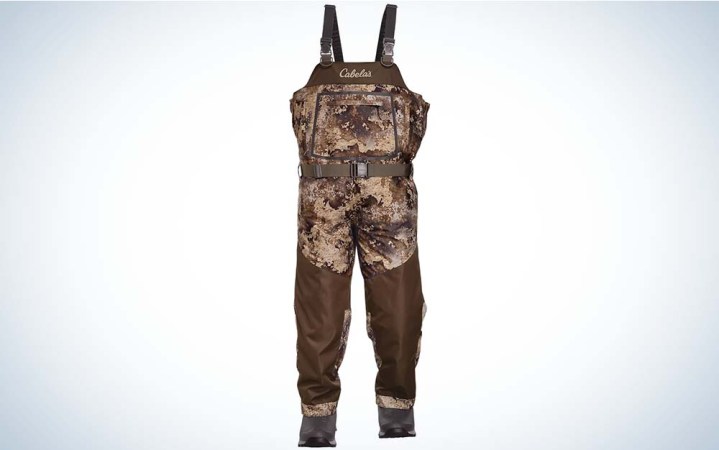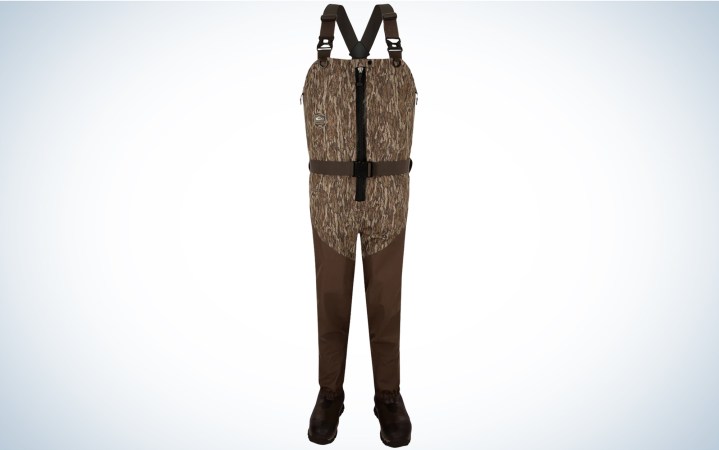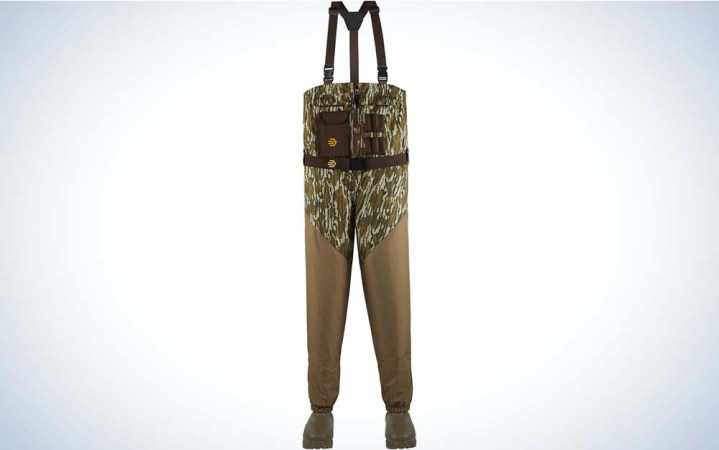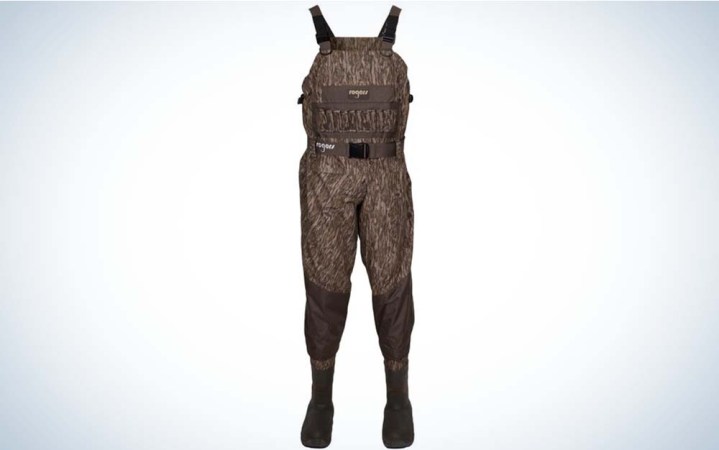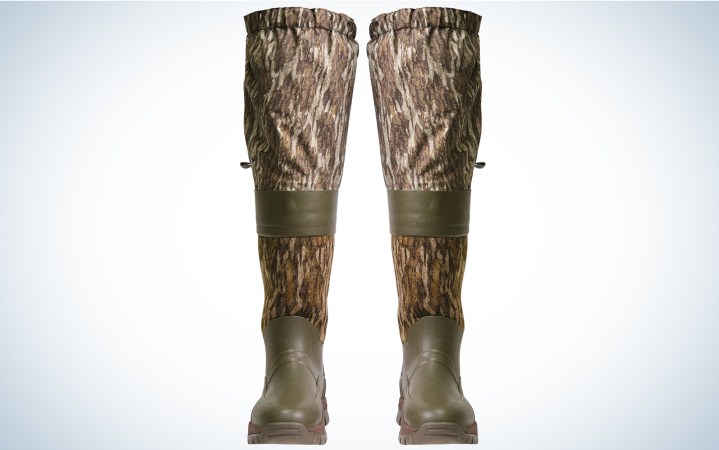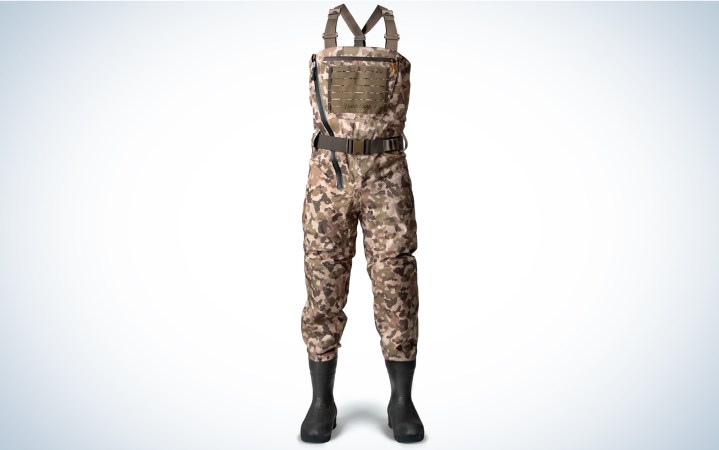We may earn revenue from the products available on this page and participate in affiliate programs. Learn More ›
Duck hunters hate buying waders. I can’t blame them. Because at some point, even the best duck hunting waders will fail you. It’s impossible for them not to. Duck hunters bend, crouch, take a knee, sit, and stand—all things that wear and tear a new pair of waders. Also, the environments we hunt are hellacious on waders. Sunken stumps, corn stalks, hog wire panels from old blinds, even the damn ice eater can rip a rubber boot and fill your shoe with ice-cold water.
I have worn all my picks for the best duck hunting waders on multiple hunts, and I combined that experience with trusted testimonials from experienced duck hunters to create this list to make the search for your next pair a bit easier.
- Best Overall: Sitka Delta Zip Wader
- Best Priced: Frogg Toggs Grand Refuge 3.0
- Most Versatile: Dan’s Frogger Bib Chest Wader
- Best Walk-In: Orvis Pro Zip Bootfoot
- Best Boot Protection: Banded Aspire Catalyst
- Most Durable: Chêne Wader
- Most Comfortable: Gator Waders Shield Insulated
- Best Engineering in a Mid-Level Wader: Cabela’s Northern Flight Renegade II
- Most Improved: Drake Uninsulated Guardian Elite HND Front Zip Waders
- Best Boot: Lacrosse Alpha Agility Select
- Warmest Wader: Rogers Elite 2-in-1 Insulated Breathable Wader
- Best Hip Boot: Chêne Slough Boot
- Best Early-Season: Duck Camp Zip Waders
How I Tested the Best Duck Hunting Waders
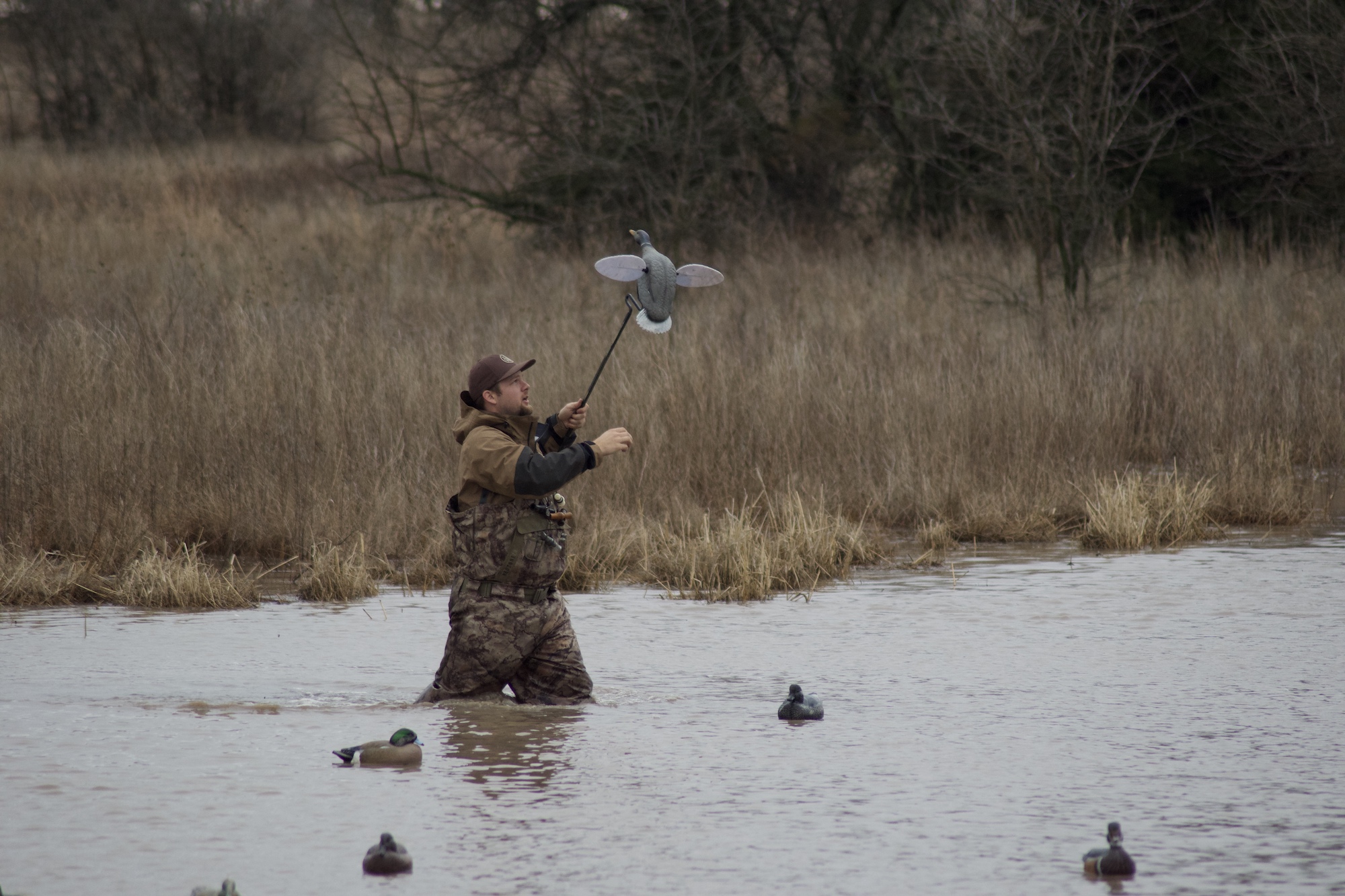
The life of each individual wader is subjective. What lasts years for one hunter may not last a month for another. I’ve hunted multiple times in most of the waders I reviewed, but never hunted in one of the waders for the entirety of a season. So, I did consider other hunters’ (whom I trust) experiences with many of the waders. I also waded up to my chest in every wader twice on separate days to make sure there were no leaks out of the box and walked a ½-mile down a levee or trail in each to see how the boot performed and to test the range of motion of each wader.
Best Duck Hunting Waders: Reviews and Recommendations
Best Overall: Sitka Delta Zip Wader
Why It Made the Cut
Delta are the best duck hunting waders overall because it’s an incredibly comfortable and durable wader that will keep your feet and body warm as long as you layer appropriately.
Key Features
- Lacrosse insulated boots
- GORE-TEX
- Waterproof YKK AQUASEAL zipper
- Reinforced knee and shin pads
- Adjustable no-buckle suspension
- Water-resistant zippered storage pockets
- Handwarmer pocket
- Boot Sizes: 9 to 13
- Sizes: Small to XXL and tall sizes
- MSRP: $999
Pros
- Extremely comfortable and lightweight
- Boot fit and warmth is unmatched
- Zip front is convenient
Cons
- They’re expensive
- The service program can be slow at times
- D-Ring placement not ideal
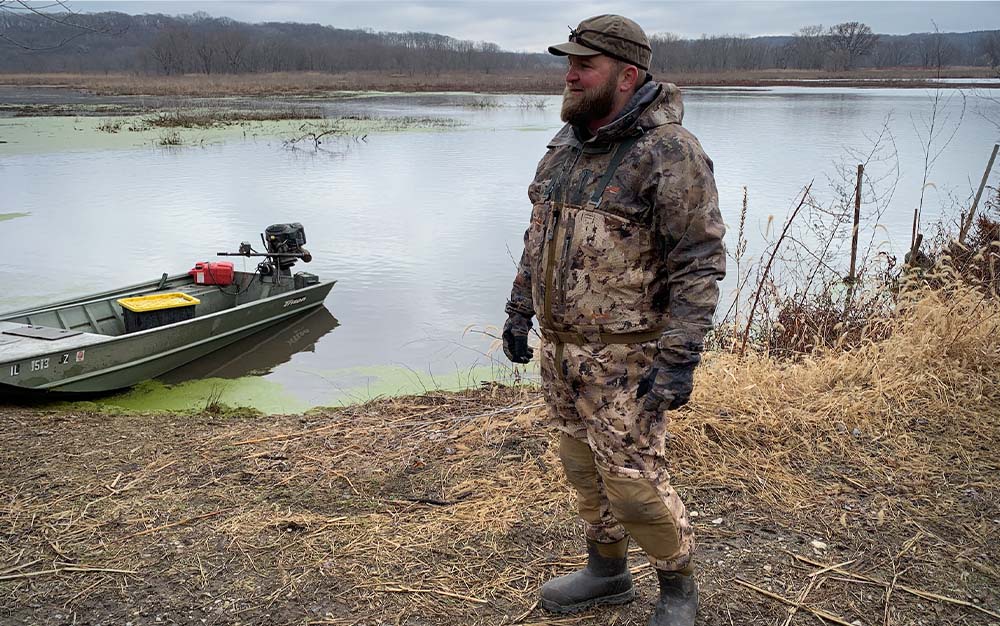
The sticker shock on the Delta is unlike almost any other piece of duck hunting gear in waterfowl. It’s tough to get past $1,000 for waders, but it is the most comfortable hunting wader I’ve worn. It’s uninsulated, which is a negative for some, but if you want to be able to move more freely, a breathable wader is the way to go. You must layer up to stay warm when it’s cold. The zip-front also makes putting on and taking off the Deltas easy. And when nature calls, it’s nice not to have to worry about your waders falling in the water. The knee and shin guards are ideal when you must break ice, or if you fall and must take a knee, it saves your joints. The Lacrosse boot is incredibly warm. While wearing these waders, I’ve never had cold feet, and the tread offered exceptional grip.
The wader straps are a hassle at first. It’s not a buckle system. A piece of steel slips into the pockets located on the straps, which gives you more adjustability, but the straps tend to fall out every time you take the waders off. There is a small hook at the top of the steel that holds the straps in place, but the strap can come loose.
That is until you get them good and muddy, and they stiffen up or dry mud sticks them to the steel insert. Also, the zipper can get stiff. There is zipper lubricant Sitka makes and sends with the waders that will help. I have sprayed it down with WD-40 or gun oil, and it slicks up. The D-ring on the elastic belt isn’t ideal. If you hook too many decoys it stretches away from the wader. Having the D-ring integrated into a steel insert on the upper or fabric of the wader would give it more strength.
There are three different color options for the Delta—Optifade Marsh and Timber or the new Earth solid. It also is available in boot sizes from 9 to 13, and comes in 11 different body sizes from small to XXL.
Best Priced Duck Hunting Waders: Frogg Toggs Grand Refuge 3.0
Why It Made the Cut
These are the best priced duck hunting waders in the review and also well constructed. You get more for your money if you buy the Grand Refuge.
Key Features
- Adjustable suspenders with low-profile buckles and D-rings
- Internal zippered flip-out, see-through pocket
- Four-ply polyester upper
- Zippered front storage pocket with quick-access, 10-count shell holder
- Internal fleece-lined hand warmer pocket
- Adjustable wading belt with locking buckle
- 120-gram quilted insulated liner
- Patented zip-in, zip-out removable insulated liner
- Heavy-duty, abrasion-resistant nylon in the shin, knee, and seat areas
- 5mm, 1,200-gram Thinsulate Ridgebuster boot
- MSRP: $300
Pros
- Zip-out liner
- Affordability
- One-year warranty
Cons
- Boot seal is unprotected
- Boot slightly heavy
- Small chest pocket
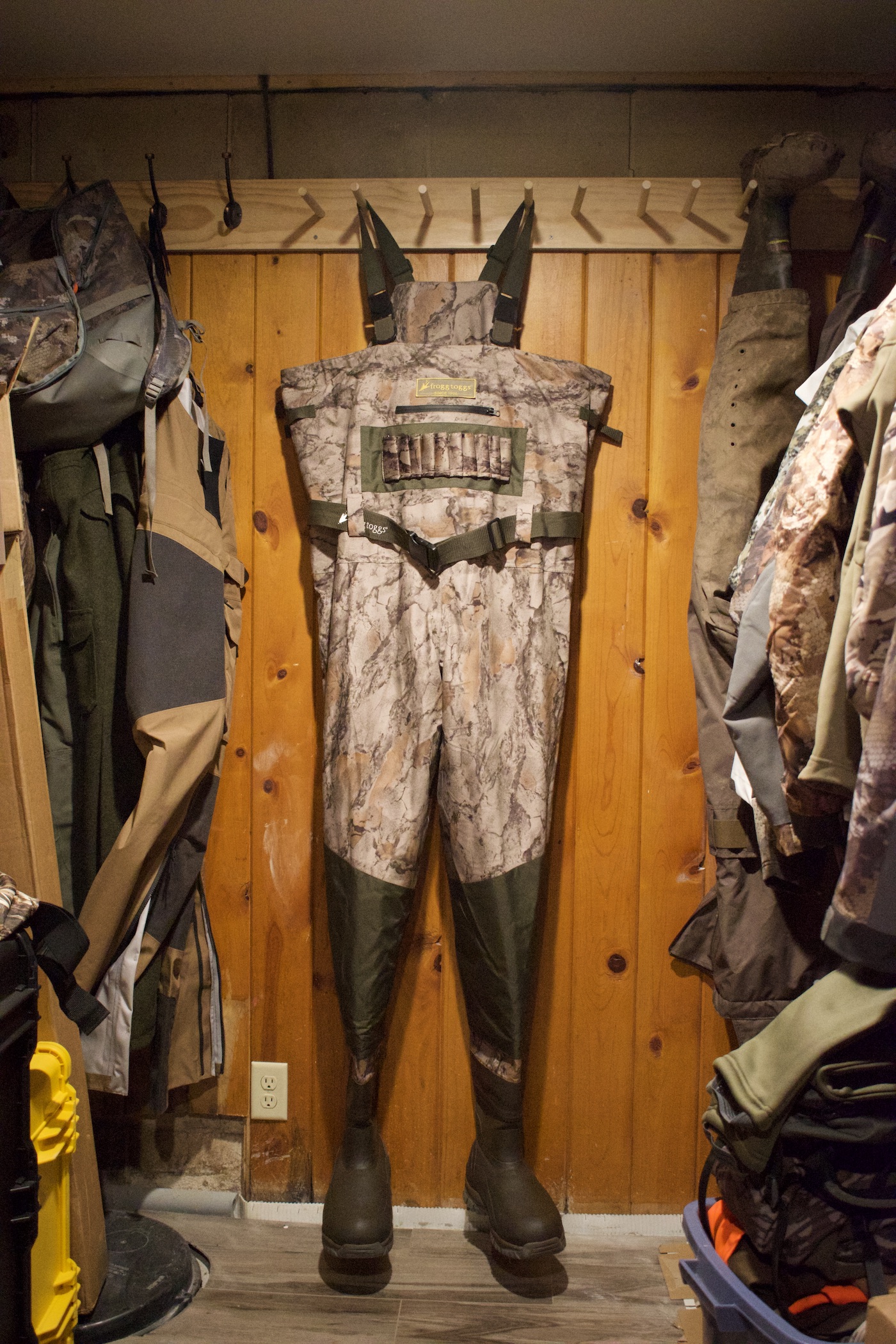
I have several frugal friends that wear these affordable, durable waders. None of those buddies reported a failure in the first season of hunting in them. The boots are excellent considering this is a $300 wader, though they are slightly heavy if you must walk into the blind. But I would put the tread and warmth of the boot up against any in this review except for Sitka, Lacrosse, and Chêne. The internal fleece-lined handwarmer keeps your hands much warmer than the pass-through types on the outside of waders. Since the warmer is on the inside of the wader you have the added warmth your own body heat provides.
A zip-out liner allows you to add insulation late-season or remove it during hot September teal hunts. The shoulder straps provide plenty of adjustment. I’m 6’4” and had plenty of stretch left in the straps. Frogg Toggs’ buckle system is a raised piece of plastic that fits into a hole on another piece of plastic affixed to the wader. You simply slide the strap up to secure it in place and it sits flat against your chest. A 10-shell holder on the chest of the wader keeps ammo at the ready, and there is also a small, zippered pocket above that for small items. There is a one-year factory warranty on the waders, which is remarkable for a $300 wader. Available in boot sizes 7 to 14 in slim, regular, or husky, and Mossy Oak, Realtree, and Natural Gear camo options.
Most Versatile Duck Hunting Waders: Dan’s Frogger Bib Chest Wader
Why It Made the Cut
These are the most versatile duck hunting waders of the bunch. You can duck or deer hunt in them. The liner is also easily replaced if it leaks.
Key Features
- Handwarmer pocket
- Expandable chest pocket
- Belt loops
- Adjustable chest cinch buckle
- 18-inch zipper for assembling
- 100 percent waterproof up to chest
- Briarproof
- True Timber Camo DRT pattern
- Waist Sizes: 38 inches (Medium), 46 inches (XL), 54 inches (3XL)
- Inseam Sizes: 29 inches and 32 inches
- MSRP: $325
Pros
- Boots don’t bind at the ankle
- Simple to repair
- Can be used for multiple hunting pursuits
Cons
- Fit wasn’t great
- No exterior pocket space
- Short shoulder straps
Waders don’t get much simpler or tougher than a pair of Dan’s. The Froggers are essentially a waterproof liner glued to a pair of insulated boots and covered with a briar-proof bib shell. So, if the waders ever spring a leak, it’s easier to pinpoint the hole and fix them because you can separate the liner from the bibs. There are no exterior frills with Dan’s, but they are comfortable. There’s a handwarmer on the outside of the front pocket, which is kept closed by Velcro. You can’t really put anything in the pocket if you want to utilize the handwarmer though.
The boots are smaller, thus lighter than most waders. You could wear these bibs in a deer stand or the duck marsh, so these bib waders are an attractive option if you hunt multiple species. There’s a zippered leg on either side, just like you get with bibs, and the boots have a neoprene upper that makes it simple to tuck your wader pants into them, so they don’t bind up.
The exterior material is briar-proof. I walked through some thorn thickets at my parent’s farm no problem. They were a little high in the crotch for me, but Dan’s has a variety of sizes to custom fit the waders to anyone. Boot sizes range from 7 to 14, and you can select from three different waist sizes (38, 46, and 58 inches) as well as a standard (29-inch) or tall (32-inch) inseam. Dan’s also caters to big guys with chest sizes over 60 inches.
Best Walk-In: Orvis Pro Zip Bootfoot
Why It Made the Cut
Orvis has been building lightweight, rugged waders you can actually move in for decades.
Key Features
- Durable four-layer cordura shell in the upper and five-layer cordura in the lower
- TIZIP Master Seal Zipper
- Vulcanized rubber over 5mm neoprene boot
- Fleece-lined hand warmer pockets
- MSRP: $898
Pros
- Michelin outsole provides non-slip grip
- Lightweight upper, lower, and boots for long walks
- T-zipper for easy on/off convenience
Cons
- Additional base layers are required to stay warm
- Sizing options are limited for bigger hunters
If you are a walk-in hunter, it’s tough to beat the comfort of Orvis’ Pro Zip Bootfoot wader. This is a fishing wader with features mobile duck hunters will appreciate. Orvis partnered with Michelin (the tire company) on the outsole of this boot for maximum tread. I’ve been wearing the wading boots for a few years, and they are ideal for muddy or slick, ice-covered levees. Traditionally, not much thought was given to waterfowl wader boots (this is changing), but you could hike up a mountain in these. Puncture-resistant four-layer cordura is featured on the upper, and you get five layers on the lower, so there is less of a chance that the waders will spring a leak.
Two side pockets are fleece-lined to keep hands warm, which you often don’t get with any breathable wader, whether it’s geared towards duck hunters or anglers. Adjustable elastic suspenders stretch as you add more layers, and don’t dig into your shoulders. There is also an adjustable belt that you can cinch tight to keep excess water from leaking into the lowers if you trip while setting decoys and take the plunge. A T-zip zipper can be easily manipulated even with gloves on, plus the waders have removable knee pads.
Best Boot Protection: Banded Aspire Catalyst
Why It Made the Cut
Banded has significantly improved this wader from its first offering—RedZone—when the company initially formed in 2014. They are more flexible, durable, and the boot has been upgraded.
Key Features
- 1600-g PrimaLoft boot insulation
- Integrated LED light system in the chest-pocket
- Over-the-boot protective pant
- PrimaLoft® aerogel insulation insert
- Uninsulated body
- Stitchless seam construction
- Fully seam taped
- Waterproof
- Boot Sizes: 8 to 13
- Fit: Regular or stout
- MSRP: $900
Pros
- Better fit than previous Banded waders
- More flexibility
- Solid boot tread
Cons
- Price
- Cheap phone pocket
- Thin boot uppers
Banded has come a long way since introducing its first RedZone wader. Their Black Label line and the RedZone 2s were significant upgrades, and the new Catalyst goes a step further. The fit of the Aspire waders is finally on point. Even though they have considerable bulk and weight, you can move freely in these waders. That wasn’t the case in previous Banded options. They were tight in the gut, crotch, and thighs, which made them hard to walk in and an absolute pain in the ass to hop into a boat from shallow water. These waders are much roomier. The boot treads are an upgrade over previous Banded waders as well. They are aggressive and give you a strong grip, though the sides of the boot uppers are a bit thin.
The fleece handwarmer snaps into the upper of the wader, so you can remove and wash the stink out of it at the end of every season. It will also keep your hands warm in the bitter cold. Above that is a cheap zippered pocket for your phone that I would not rely on to keep it protected from the elements. There’s another fleece-lined pocket on the front of the upper, and a second horizontal pocket for storage.
A flap conceals a small light bar above that pocket kept closed by magnets. A small battery pack that runs on three AAAs (sold separately) is concealed inside the wader. I pulled out the pack to put batteries in, but it was not easy to get the pack back into the pocket it stays in, so I just pulled the whole unit out. Also, the fact that you must buy batteries for such a pricey wader is a little off-putting. Knee and shin padding were stitched onto the exterior of the wader pant. They will provide some protection, but it’s a thin layer of material.
Banded made great strides with the Aspire, but the pricing is high at $900. You do get a 3-year no-hassle warranty that covers workmanship and materials (but you may still have to pay something out of pocket). It’s available in boot sizes 8 to 14 (regular) and 10 to 13 (stout) in brown, Mossy Oak Bottomland, and Realtree Max-5.
Most Durable Duck Hunting Waders: Chêne Wader
Why It Made the Cut
The Chêne wader’s construction will keep you warm despite the fact that it is an uninsulated, breathable wader. You can tell this is a premium wader out of the box.
Key Features
- Stitchless seams
- Waterproof
- Waterproof YKK AQUASEAL front zipper
- Water-resistant pocket zippers
- Handwarmer pockets
- Interior storage pockets with magnetic closures
- Boot covers with vertical drain vent
- 1200g Thinsulate boot insulation
- Boot Sizes: 9 to 13
- Body Sizes: Medium to 3XL
- MSRP: $1,099
Pros
- Wader material is extremely durable
- Comfortable boot
- Superior mobility
Cons
- Price
- Fit is average for bigger hunters
- No D-Ring to hook decoys on to
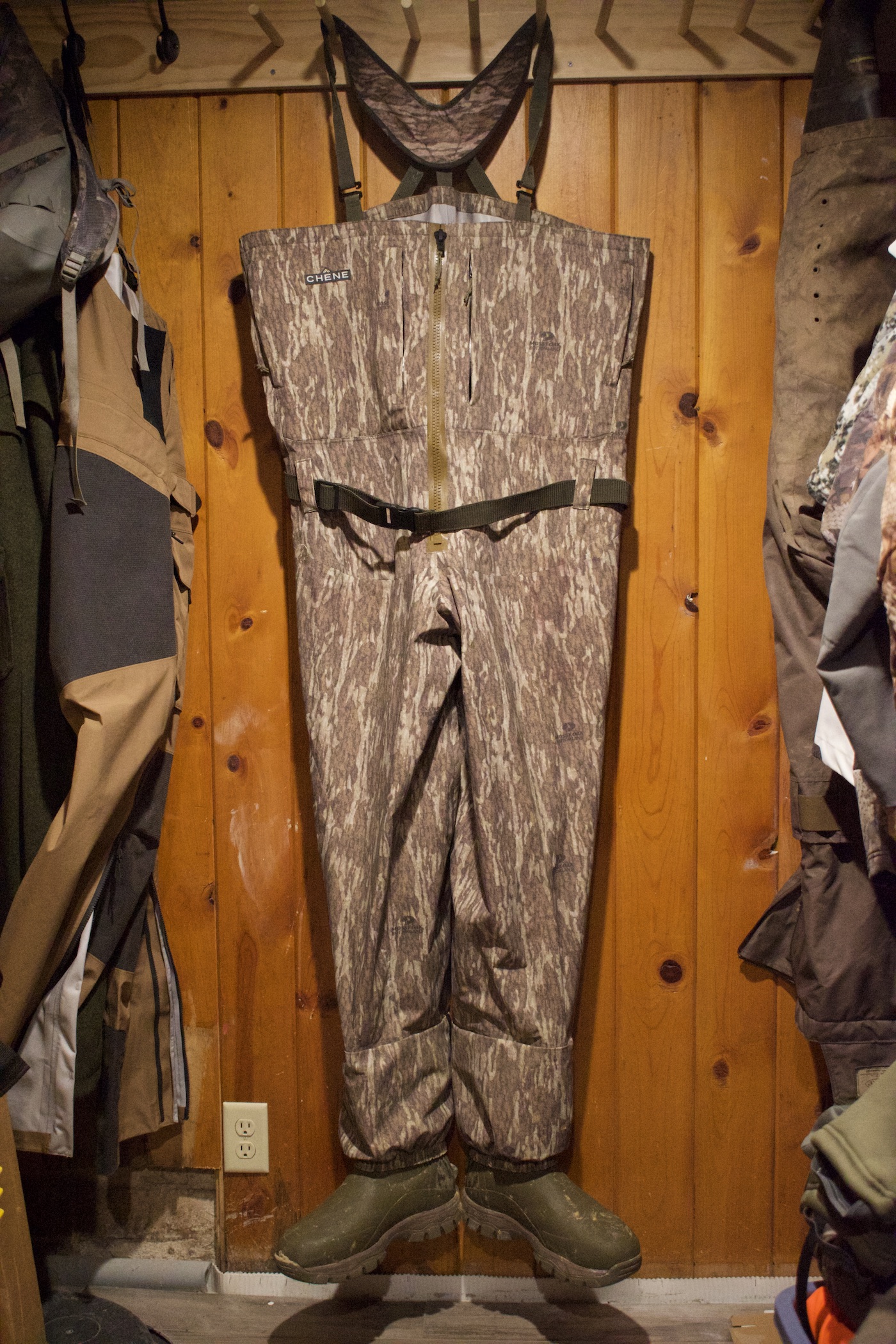
As the most durable duck hunting waders the construction of these waders was one of the best of the review, which is to be expected, because they are also the most expensive. Chêne built its wader with a four-layer nylon fabric that is thick and durable. You can feel the quality of the material as soon as you take the waders out of the box. The boots, constructed of 5mm neoprene with a rubber overlay, are comfortable, though after standing in them for a few hours of hunting, my feet did begin to ache slightly. It was tolerable.
They are also warm with 1200 grams of Thinsulate. There are covers that slide over the boot so the weld from the boot to the nylon wader material is better protected from sharp objects you can’t see underwater. The front zip waders utilize a YKK zipper that keeps water out, but when you first receive the waders it’s hard to unzip. I ended up using a piece of paracord from one of the pocket zippers and looping it through the front zipper to make it easier. YKK zippers are known for being stiff. It’s a byproduct of keeping you dry, but Chêne should have designed the waders to unzip with more ease.
The wader upper has two zippered fleece handwarmer pockets, and two more deep zippered pockets on either side of the YKK. There are a pair of internal pockets that use a magnet to stay closed, so you can keep small items secure. The wader belt stretches but is also rigid, so it doesn’t pull too far away from your waders if it hangs up on a branch and is less likely to tear. Average-sized hunters will like the fit of the waders. They are spacious and flexible. If you are tall, the Chênes will ride up into the crotch a bit. It’s not terribly uncomfortable, but it is noticeable. Also, the wader straps need to be a little longer.
They are built of the same strong material as the belt and steel loops can be inserted into multiple slots on the straps for adjustment. But at 6’4”, I’d like to have a few more loops so I can comfortably tuck a parka into the waders. As it stands, the straps and harness they are attached to put a significant amount of pressure on my shoulders when I add a jacket. A limited lifetime warranty comes with the waders, which are available in boot sizes from 9 to 13, body sizes medium to 3XL, and Mossy Oak Bottomland camo or Drab Green solid.
Most Comfortable Waders: Gator Waders Shield Insulated
Why It Made the Cut
The fit of Gator Waders is incredible when you consider the $400 price tag. Most mid-level waders are not as comfortable.
Key Features
- Rugged four-layer polyester exterior shell
- Double-stitched and dual-sealed two-layer seal taped seams
- Magnetic chest pocket
- Quilted thermal cotton insulated internal liner
- Fleece-lined handwarmer pocket
- Heavy-duty elastic shoulder straps and belt
- 900D reinforced rear seat and leg gaiters
- Improved aggressive tread design with a reinforced exterior rubber boot
- 1600g insulated boot
- MSRP: $400
Pros
- Highly adjustable shoulder straps
- Roomy
- Priced right
Cons
- Thin boot sole
- Shotshell holder stitching weak
- Not a great warm-weather wader (there is an uninsulated version)
When Sitka introduced the Delta at almost $1,000, a few companies decided to start charging more for their waders without really upgrading them that much. Gator Waders didn’t do that, which makes the Shields one of the best buys for the money in this review. It’s not a premium-level wader, but the fit is excellent, and you get just about everything you need in a functional duck hunting wader.
The snap buckle straps are attached to a padded shoulder rest, so you can layer up without feeling any pressure on your neck and back. There are two plastic D-rings on the chest, and though they may not be ultra-durable, they are thick enough to last the life of the wader. You also get a large front chest pocket for storage and a fleece-lined handwarmer in front of it. Six elastic shotshell holders are also stitched onto the front of the handwarmer.
Quilted thermal cotton lines the interior of the water from the chest down to the top of the rubber boot. You can also get the Shield in an uninsulated version. The 1600-gram Thinsulate boots are plenty warm, but the soles are thin, so if you stand a lot when you hunt, your feet will feel it. The treads are aggressive, and I didn’t experience any slippage while wading or walking down levees. Gator waders only come in even shoe sizes eight to 14, and you can order them in regular, stout, long or king. The Shields also come in Realtree and Mossy Oak camouflages, plus a brown solid.
Best Engineering in a Mid-Level Waders: Cabela’s Northern Flight Renegade II
Why It Made the Cut
Cabela’s started to put more effort into the design of its waders with the debut of the Renegade. That continues with the second generation of the wader, which has a warmer boot and a wide range of adjustability in the shoulders.
Key Features
- Warm, breathable, and protective hunting waders
- Breathable, four-layer uppers
- 200-gram 3M Thinsulate Insulation throughout the upper
- Comfortable and seamless injected natural rubber boots with 1,600-gram 3M Thinsulate Insulation
- Advanced all natural cork insoles: moisture-wicking, advanced cushioning
- Tough 900-denier outer layer over the knees and seat areas
- Large pass-through hand warmer pocket features a soft fleece lining
- Storm-flapped storage pocket with water-resistant YKK zipper
- Shoulder straps can be set different ways for shooting comfort
- High-traction combination outsoles—pairs air bobs with hunting tread
- Wader safety belt included
- MSRP: $360
Pros
- Better engineered than previous Cabela’s waders
- More aggressive tread and warmer boot
- Superior adjustability in shoulder straps
Cons
- Boot fit is not ideal
- Overall fit of the wader is below average
- Too heavy
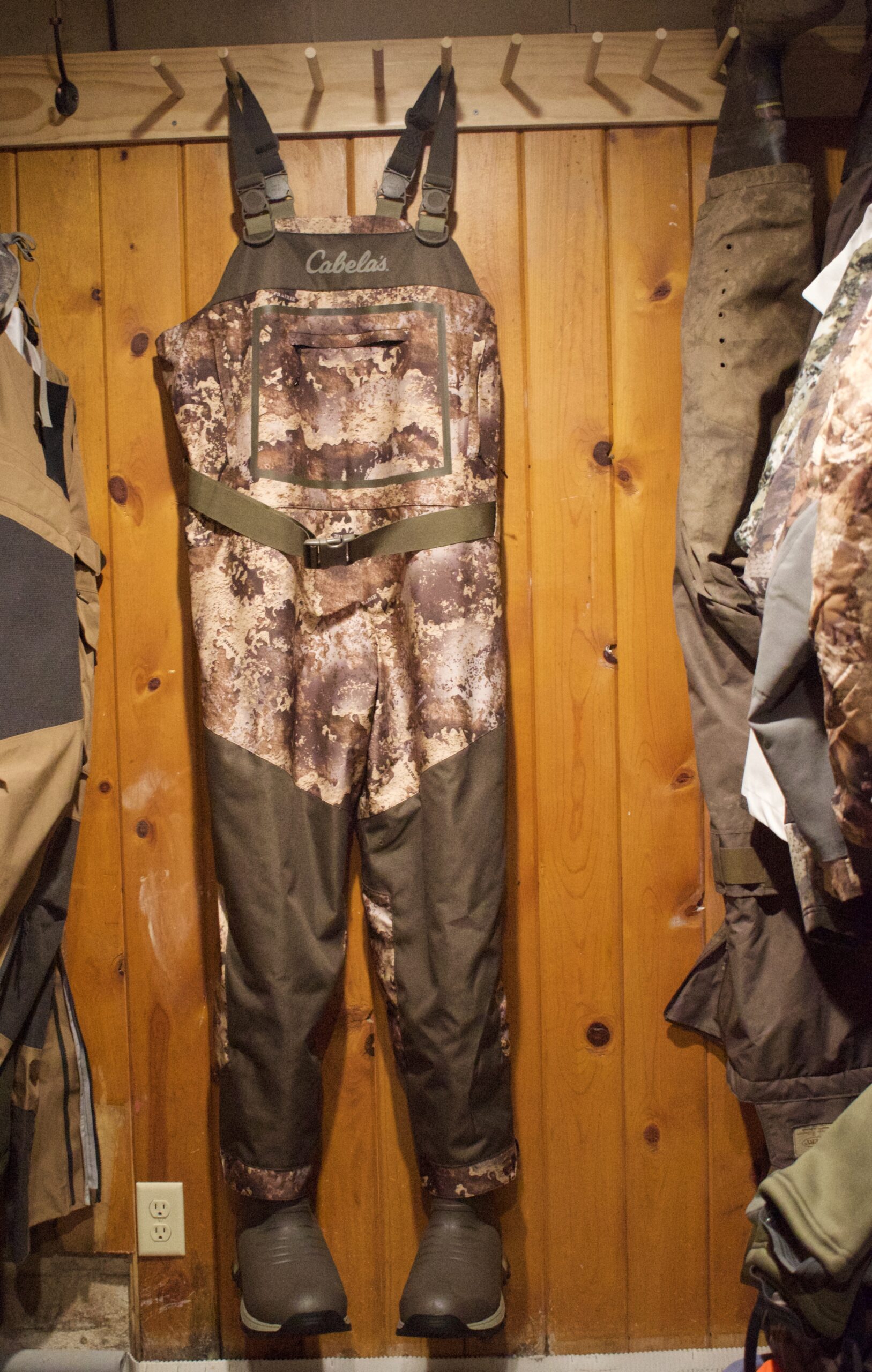
Cabela’s used to make simple waders that lasted for years (I had a pair of Dry-Plus waders that made it through eight seasons), and if they didn’t, the replacement program allowed you to bring the old waders in and get a new pair. Those days are gone, but Cabela’s is trying to engineer its wader line better. The first thing most hunters will be shocked by is the amount of design that has gone into them. Extra 900-denier material was thoughtfully added to the knees and seat since those are the areas that see the most use. The shoulder straps unbuckle at either end, so you can configure them in different ways for a superior fit. There is also a large fleece-lined pass-through handwarmer, and a zippered front pocket for small items, like keys or a phone.
The boots have also been upgraded from the standard rubbers that Cabela’s previously employed. The old boots on waders like the Super Mags didn’t provide much grip or warmth at all. These new ones have a more aggressive tread and 1,600 grams of Thinsulate. But they are heavy. My waders tipped the scales at 14 pounds, so if you are a walk-in hunter, these are not an ideal choice. And even though the Renegades are easy to slide on and off, the boot upper bound up badly to the point I wanted to take the waders off after 20 minutes.
It may not be as bad for you, because I have tree-trunk-sized legs. These waders do have a 200-gram Thinsulate liner that will keep you warm, but I would not recommend wearing them during warm-weather hunts. You’ll be sweating buckets. Sizing availability on these waders will vary while supply chain issues continue, but Cabela’s anticipates having boot sizes from 8 to 15. These duck hunting waders are available in True Timber Prairie camouflage.
Most Improved: Drake Uninsulated Guardian Elite HND Front Zip Waders
Why It Made the Cut
Drake continues to up its wader game, adding a more wearable boot with an aggressive tread that offers improved comfort and grip.
Key Features
- TIZIP MasterSeal 10 zipper
- Four- and five-layer fabrics treated with DWR (Durable Water Repellent)
- Reinforced taped seams
- Boot with EVA midsole and rubber-molded outsole
- Two Magnattach front call pockets
- MSRP: $600
Pros
- Boots are the best Drake has ever offered
- T-zip front zipper adds convenience for taking waders on/off
- Chest pockets and internal fleece-lined hand warmer pocket
- Sizing up to 3XL-Tall and 14 boot
Cons
- Slender hunters may find the wader fit bulky
- Boots are still a bit heavy for a $600 wader
After an executive change in April 2022, Drake has been dedicated to upgrading its waterfowl, turkey, and whitetail lines. One of the most notable examples is the Guardian Elite HND wader, which has an all new boot this year. For years, Drake had a fairly standard, heavy wader boot that didn’t offer hunters much grip, warmth, or comfort. That’s all changed with the new EVA midsole, rubber-molded outsole, and 1,600 grams of insulation. The lower portion of the Guardian Elite was constructed of five-layer fabric treated with DWR. Drake includes the same treatment on the four-layer upper.
The front zipper is more heavy-duty than it has been in the past, as is the waist belt. This makes it easier to gear up, especially in the dark. It also shows that Drake is paying close attention to some of the finer details of its wader, which hunters paying $600 to keep dry appreciate. All seams are reinforced and taped, plus Drake cut back 75 percent of the needle holes it made on previous designs—that means fewer opportunities for water to seep in. Magnetic front pockets are roomy, and there is a side zippered pocket for your cell phone, though it’s not completely waterproof (most veteran duck hunters invest in some type of waterproof phone case). There is an internal fleece-lined hand warmer as well to keep fingers warm when you’re not hail calling at migrators or pulling the trigger.
Best Boot: Lacrosse Alpha Agility Select
Why It Made the Cut
The boot-fit on this wader is the best of the bunch despite the fact that they are the most difficult to take off. They are also priced right.
Key Features
- Lightweight, breathable, abrasion-resistant nylon is 100 percent waterproof with double-stitched and taped seams
- Removable liner with 120G quilted insulation
- Integrated neoprene stretch-fit shell loops for convenience
- YKK waterproof front zipper for easy on/off
- Hand-laid premium rubber over a 7mm neoprene core for flexible, waterproof comfort
- 1600G Thinsulate Ultra Insulation for lightweight warmth
- Specially formulated LXA midsole compound gives athletic shoe-like agility and cushion for all-day use
- MSRP: $550
Pros
- Boot fit and comfort
- Removable liner
- Priced right for the amount of engineering that went into the wader
Cons
- Wader fit is average
- Boots are tough to take off
- Shoulder straps fixed to the upper
Lacrosse delivered on the boot of this wader, which is to be expected since they have been making boots for more than a century. Lacrosse engineered the boot for Sitka’s Delta, but the boot on the Alpha is different, though it has the same superior grip, comfort, and warmth as the one you will find on the Delta. And the fit of the boot is unmatched. Your foot will not slip out of them. The one drawback is they are hard to take off after the hunt.
I had to sit down on the truck tailgate to take the second boot off with my hands. The exterior of the boot is slick, so it’s hard to kick them off without putting your hands on them. That’s not a deal-breaker, but it would have been easy to add a rubber stud on the heel of each boot to make it easier to get them off. Instead, you’ll have hands full of mud at the end of your hunt if you can’t wash the waders with a hose before slipping back into your Crocs.
There’s a removable liner in these duck hunting waders, which makes it more versatile since the weather varies so much throughout duck season. The comfort of the waders is on par with some of the better waders in the review. Just make sure you consider your body size before ordering. They come in medium, stout, and king. I made the mistake of ordering the mediums first time around and they were too tight for my 6’4”, 275-pound frame. Durable Nylon extends from the mid-thigh down to the ankle for added durability.
Mobility isn’t great in the Alphas. I struggled to lift my leg more than 10 inches off the ground. That’s not ideal when you’re climbing into a boat or need to step up into the blind. The straps have enough elasticity in them, so they don’t pinch or put pressure on your shoulders. But they are fixed to the wader uppers, and you can’t unbuckle them. That makes it a chore to put them on. There are six shell holders on the chest, and a waterproof Velcro “tech pouch” holds your phone. It’s an odd feature you won’t find on any other wader, and though I wouldn’t use it, props to Lacrosse for trying to keep our electronics safe. The Alphas are available in boot sizes 7 to 15 and in Realtree Max-5 camo.
Warmest Duck Hunting Waders: Rogers Elite 2-in-1 Insulated Breathable Wader
Why It Made the Cut
Like the Frogg Toggs, this wader is affordable, but also built extremely well for such an inexpensive wader.
Key Features
- G-hook shoulder strap connection
- 80 grams Primaloft silver zip-out liner
- 3.5mm fleece-lined 1200g Thinsulate neoprene boot
- Internal water-resistant cellphone pocket
- Internal fleece handwarmer pocket
- External storage pocket
- 11 shell loops
- Heavy-duty, abrasion-resistant nylon shin, knees, and seat
- Side cinch and drawstring top
- D-rings
- Fit: Slim, Regular, Husky
- Boot Sizes: 9 to 14
Pros
- Affordable
- Zip-Out liner
- Quality boot
Cons
- Short shoulder straps
- Boots are slightly heavy
- Poor belt loop stitching
Roger’s 2-in-1 is one of the best waders for the money in this review. The boot on these waders has as much grip as any I’ve worn and the 1200 grams of Thinsulate make them plenty warm, though they are a little heavy for walk-in hunts. There is also a quilted 120-gram Primaloft zip outliner, so you can hunt comfortably in the 2-in-1s on early teal and late-season goose hunts. The knees and shins aren’t padded but are reinforced with a heavier nylon material than the rest of the waders. A fleece hand warmer stitched inside the chest will save your fingers on bitter-cold hunts, especially if you don’t like to wear gloves. A flip-out plastic phone case just above the hand warmer will also keep your phone reasonably dry and protected.
The shotshell holders in the front of the waders have some elasticity to them, so it’s easy to slip in even 10-gauge loads. I pulled on each one of the holders multiple times to see if they would rip and none of them did. The front chest pocket is zippered and shielded by a flap. The pocket is deep enough for extra shells, an e-collar remote, or any other small essentials you take to the blind. The shoulder straps are like Sitka’s no buckle system, except the metal holders are bigger, which help the straps hold in place better. The only issue I had (because I am 6-foot-4) was the straps were a little short. They were fine if I just had a sweatshirt on, but it was a tight fit once I started layering.
The belt loops on the waders were flimsy. One hard tug, and the stitching pulled away from the waders. That’s not a deal-breaker though, because you can always re-stitch them or just wear the belt without the loops. The waders are available in boot sizes from 8 to 15 (Husky, Regular, or Slim fit) in brown, Mossy Oak Bottomland, Habitat, Realtree Max-5, and Timber. MSRP: $300-350
Best Hip Boot: Chêne Slough Boot
Why It Made the Cut
The Slough Boot is much more versatile than a traditional hip wader, allowing hunters to wear it like a rubber boot or extend the 12-inch nylon to keep dry in deeper water.
Key Features
- 3mm neoprene with 2mm air mesh lining
- Rubber heel kicker with 3D logo
- Molded rubber outsole
- 7mm comfortable EVA innersole
- MSRP: $300
Pros
- Wears like a knee or hip boot
- Air mesh liner stops swamp foot
- Can be worn for multiple hunting pursuits
Cons
- Not as much waterproof coverage as a hip wader
- Connection strap can catch on tree limbs or brush
The Slough Boot is a combination of the Chene’s nylon wader material (upper), 3mm neoprene (middle), and knee boot (lower). A 7mm innersole makes for a non-slip fit and the tread of the outsole offers superior grip in marsh or timber. There is also a rubber heel-kicker that makes sliding the boots off easy.
The 12-inch nylon upper has a piece of elastic built into the top so that it secures around your leg. There is an 9- to 16-inch adjustable strap with a webbing clip that can be attached to the belt loop of your pants. The upper folds down as well, so the boot can be worn like a knee boot. An air-mesh lining allows you to wear the Slough Boot in all seasons, wicking sweat away from your foot. So whether you are planting millet on a mudflat in summer, hunting early-season teal, or flooded timber during big duck season, the boot will keep you comfortable.
You can also wear it for deer or turkey season if the property you hunt has a creek running through it or marshy areas where the water is over knee deep. My only complaint is that the strap from the upper to the belt loop could get snagged on brush as you slog through the woods or hang up on an unseen tree limb in the dark. Chêne offers the boot in Mossy Oak Bottomland.
Best Early-Season: Duck Camp Zip Waders
Why It Made the Cut
If you hunt warm weather, like Texas where Duck Camp is located, or California, these waders are ideal for such a climate due to their light weight and maneuverability.
Key Features
- Asymmetrical zipper
- Suspension system is easy to adjust with low-profile buckles
- Pass through chest pocket
- Chest panel compatible with Molle attachments
- Removable shin and knee pads
- MSRP: $749
Pros
- Nylon/polyester blend fabric is breathable
- Wader material is non-restrictive, making it easier to walk, kneel, etc.
- Low-profile buckles are unobtrusive when shooting
Cons
- Boot is fairly standard for a pricey wader
- Side zipper can be difficult to manipulate
You can tell the Duck Camp Zip wader was built for the balmy south Texas duck season (Duck Camp is based in Austin) as soon as you put them on. The lightweight material breathes in sticky summer conditions so you don’t sweat out of your waders, and the boot has just 1,000 grams of Thinsulate. An innovative waterproof side zipper was integrated into this wader so that a pass through pocket could be built into the chest. There is also a zippered chest pocket that can hold small items like keys or a phone. A daisy chain chest panel is compatible with Molle attachments, so you could secure a small tactical pack (about the size of a Dopp kit) to the front of the waders for additional storage. Clasps or carabiners are also a smart option for deploying decoys and picking them up.
One drawback of the side zipper is that your right hand has to stretch in an awkward position (this may not be the case if you have shorter arms) to hold the top of the wader when you unzip. It’s a minor inconvenience, but one you should be aware of when buying a premium priced wader. The buckles are low profile and tuck into the inside of the wader so they won’t get in the way when you bring a shotgun to your shoulder. There is also a unique side release that you must pinch with both fingers to unbuckle. Removable shin and knee guards will save your legs. The boot is standard issue, but comfortable. Duck Camp offers the waders in their Woodland and Wetland camouflages with a limited lifetime warranty that covers the materials and workmanship for the life of the waders.
How to Buy the Best Duck Hunting Waders
Most waders fail because they get stretched and pulled by your movements. It’s just like a pair of jeans. The more you wear them, the more you wear them out. Also, boots spring leaks where the rubber meets the wader material because that part of the wader is submerged under the pressure of water the most. It’s always smart to inspect waders at the stitching, seams, and seals before you buy or wear them outside (if you order online), because these are the places most likely to succumb to tears and leaks. If they look shoddy, they likely are, and you should pass on them in favor of a more well-made pair.
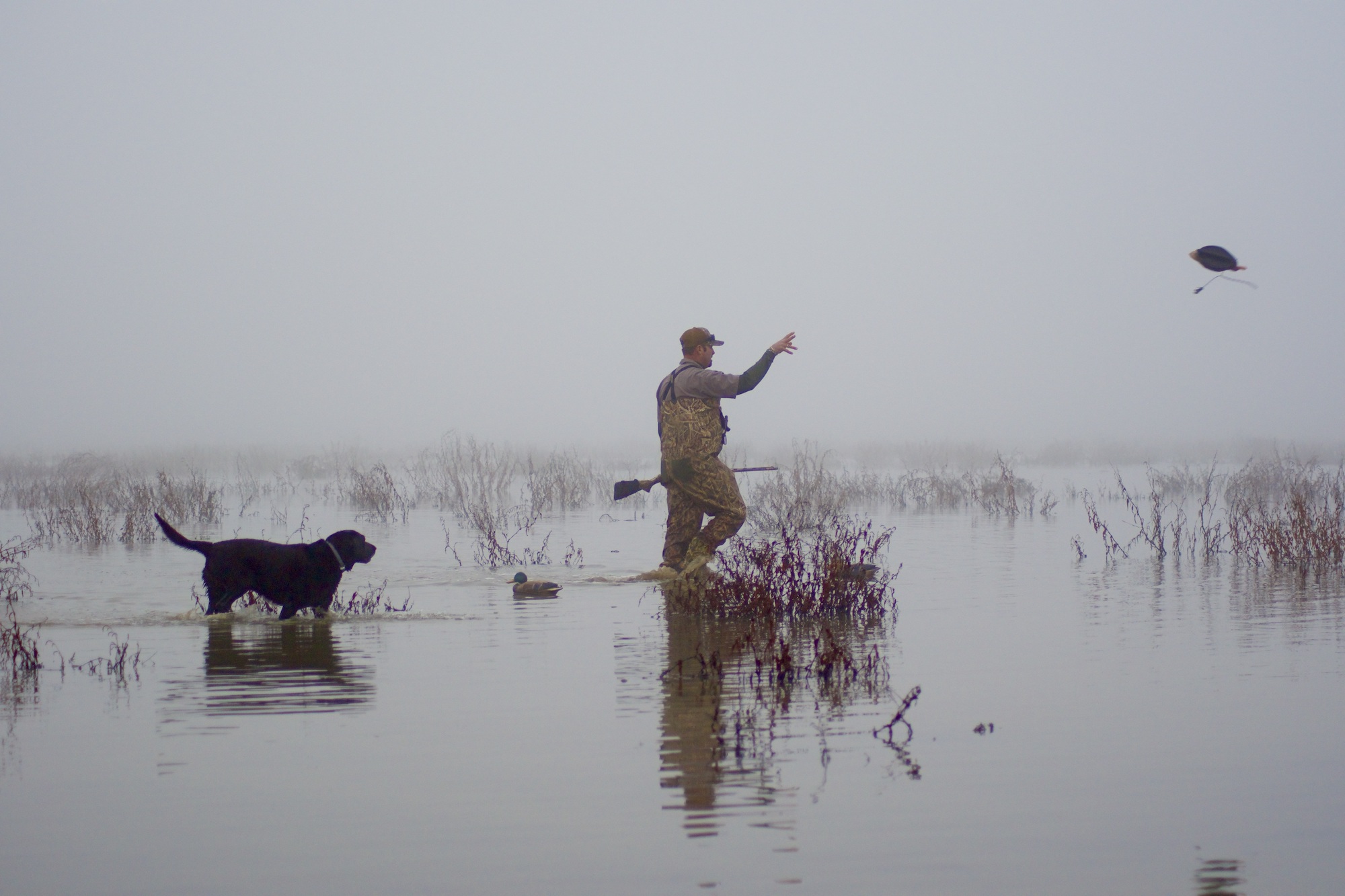
Every individual wader fits differently, but luckily you can try them on before purchase, or if you buy them online, try on at home and have the option of returning. I recommend the second option because you can test them. Just fill a bathtub up with water, get in with your waders on, and see if they leak out of the box (a pool works too if you have access to one).
Find duck hunting waders that don’t tighten when you walk, sit, or take a knee. If you put waders on and you can’t bring your foot off the ground more than a few inches or the waders suck you in like a girdle when you sit down, don’t buy them. They will likely break down on you quickly because you are putting pressure on the seams and stitching. Some waders have a high crotch too, which is why so many of them spring a leak there. You’ll know immediately if a wader is tight in that area.
The boot-fit of waders has come a long way in just the last six or seven years. How a boot fit your foot was not much of a consideration in product development until the last decade. Most waders had boots with a skinny upper that would bind, but the boot itself was often too big for your foot, which added more weight to the waders. It also allowed more mud to get stuck to them, which made the boots even heavier and thus harder to walk as far as you might need to get to the ducks.
Boot treads were also an afterthought. As soon as any amount of mud stuck to your boots, it was like walking on ice. That has changed. Sitka made every other manufacturer of waders step its game up by partnering with Lacrosse on the boot of its Delta wader. The boot forms to your foot, and the tread is far better than any wader that had come before it. The Delta was the first hunting wader that paired with a proven bootmaker. There should be no reason to buy a wader that doesn’t have a comfortable boot with plenty of grip.
Advice on Buying Duck Hunting Waders
As you read through the reviews, keep in mind you have the option of deciding if you want to buy an inexpensive pair every year or two, or invest in a pricey pair of waders with a service program or extended warranty. It’s still a tough choice to make. Because, like I said, someday your waders will fail—likely when you need them to perform—regardless of how much money you invest in them. You must think about how much or little you hunt, and then consider whether or not the cost matches up with the amount of time you end standing in the water staring at skies (hopefully) full of ducks.
FAQs
How long a wader lasts depends on how well it was made and how badly you abuse it. Duck guides will often run through a single pair (or at least have a failure that will need repair) in one season because they hunt so much. If you only hunt a handful of times each season, you can get years out of a wader. There’s no national average on how long waders will last, that’s why it’s important to check the warranty before buying. Because any wader, no matter the price, can leak out the box.
Some high-end waders are worth the price you pay for them. The cost of waders has gone up in the past five years because some companies have chosen to use better quality materials in the construction of their waders. But other companies have simply jacked up the price of their waders without improving them. A “high-end” wader is breathable, flexible, has a warm boot, and a solid boot tread. If the waders you are considering buying don’t at least have these four amenities, they are not a premium wader.
To choose the right size waders, you simply need to know your boot size, inseam, and chest measurements. Most wader companies have sizing charts so you can match up your body type to the right size wader. A majority of the manufacturers go by regular, stout, and king sizes. If you’re average sized, pick regular; short and round, pick stout; big and tall, pick king.
Final Thoughts on the Best Duck Hunting Waders
The evolution of duck hunting hunting waders in the last decade has been exceptional. We have moved on from neoprene models that were tough to put on, take off, move in, and didn’t add much warmth on cold days. Today’s hunters have more range of motion, and a better fit—from the boot to the body of the wader—than ever before.
Waders will leak at some point, but if you decide to buy a premium wader, there are favorable warranty options that allow you to invest in one pair for the rest of your hunting career. Or you can go the other route and buy a less expensive wader that may not last as long. But overall, those waders, like the Grand Refuge or offerings from Gator Waders, are being built to last longer, so your dollar stretches farther. There is no shortage of options. It’s just a matter of finding the wader that best fits your hunting style and budget.
- Best Overall: Sitka Delta Zip Wader
- Best Priced: Frogg Toggs Grand Refuge 3.0
- Most Versatile: Dan’s Frogger Bib Chest Wader
- Best Walk-In: Orvis Pro Zip Bootfoot
- Best Boot Protection: Banded Aspire Catalyst
- Most Durable: Chêne Wader
- Most Comfortable: Gator Waders Shield Insulated
- Best Engineering in a Mid-Level Wader: Cabela’s Northern Flight Renegade II
- Most Improved: Drake Uninsulated Guardian Elite HND Front Zip Waders
- Best Boot: Lacrosse Alpha Agility Select
- Warmest Wader: Rogers Elite 2-in-1 Insulated Breathable Wader
- Best Hip Boot: Chêne Slough Boot
- Best Early-Season: Duck Camp Zip Waders
